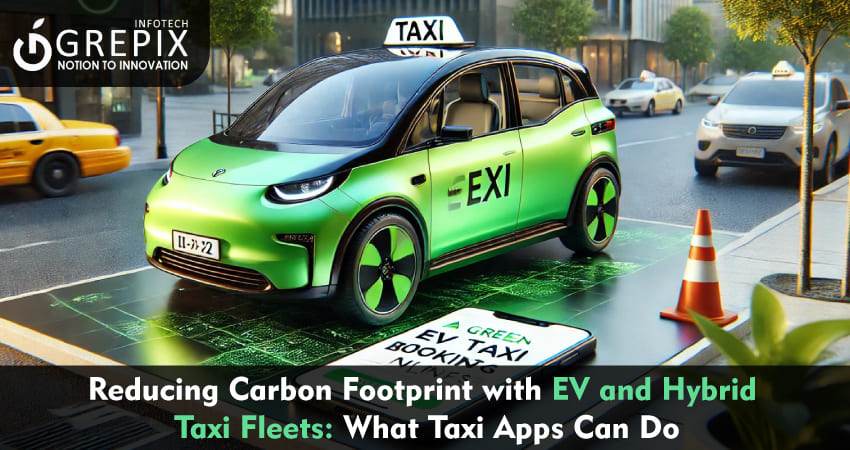Reducing Carbon Footprint with EV and Hybrid Taxi Fleets: What Taxi Apps Can Do
The transportation sector is one of the largest contributors to global greenhouse gas emissions, accounting for approximately 24% of CO2 emissions from fuel combustion worldwide. As urbanization accelerates and the demand for mobility services grows, the environmental impact of transportation becomes increasingly significant. Taxis and ride-hailing services play a pivotal role in urban mobility, making them a critical focus area for reducing carbon emissions. The integration of electric vehicles (EVs) and hybrid vehicles into taxi fleets presents a substantial opportunity to mitigate environmental impacts. Moreover, taxi apps, as the interface between drivers, passengers, and service providers, have a unique position to facilitate this transition. This article explores how taxi apps can contribute to reducing the carbon footprint by promoting and supporting the use of EVs and hybrid taxi fleets.
The transportation sector significantly contributes to global CO2 emissions, primarily from fuel combustion, accounting for about 24% worldwide. Urbanization and increasing mobility service demands amplify the sector's environmental impacts, with taxis and ride-hailing services playing a crucial role. Transitioning taxi fleets to electric (EV) and hybrid vehicles offers a practical solution to mitigate these impacts. Despite challenges like high costs, limited charging infrastructure, and regulatory hurdles, taxi apps can drive this shift. They can incentivize drivers, optimize fleet operations, enhance charging access, educate users, and foster policy advocacy. By promoting EV and hybrid use, taxi apps can significantly reduce the transportation sector's carbon footprint, exemplified by successful initiatives from companies like Uber, Bolt, and Didi Chuxing.
The Environmental Impact of Conventional Taxi Fleets
Traditional taxi fleets predominantly consist of vehicles powered by internal combustion engines (ICE), which emit significant amounts of carbon dioxide (CO2) and other pollutants such as nitrogen oxides (NOx) and particulate matter (PM). These emissions contribute to air pollution and have adverse effects on public health and the environment. In densely populated urban areas, the concentration of taxis amplifies these impacts.
The Shift to EV and Hybrid Taxi Fleets
Electric vehicles and hybrid vehicles offer a cleaner alternative to conventional ICE vehicles. EVs produce zero tailpipe emissions, and hybrids significantly reduce emissions by combining an internal combustion engine with an electric motor. Transitioning taxi fleets to EVs and hybrids can lead to substantial reductions in greenhouse gas emissions and improve urban air quality.
Challenges in Transitioning to EV and Hybrid Fleets
Despite the environmental benefits, several challenges hinder the widespread adoption of EVs and hybrids in taxi fleets:
- High Upfront Costs: EVs and hybrids often have higher purchase prices compared to traditional vehicles.
- Limited Charging Infrastructure: Inadequate availability of charging stations can lead to range anxiety among drivers.
- Long Charging Times: EVs require longer periods to recharge compared to refueling ICE vehicles.
- Battery Degradation: The high mileage typical of taxi services can lead to faster battery degradation.
- Regulatory Hurdles: Lack of supportive policies or incentives from governments can slow down the transition.
The Role of Taxi Apps in Reducing Carbon Footprint
Taxi apps can play a transformative role in overcoming these challenges and promoting the adoption of EVs and hybrids. Here's how:
1Incentivizing Drivers to Adopt EVs and Hybrids
- Financial Incentives: Taxi apps can offer reduced commission fees or bonuses to drivers who use EVs or hybrids. This can offset the higher initial costs and encourage more drivers to switch.
- Access to Exclusive Features: Providing EV and hybrid drivers with access to premium features, such as priority dispatching or exclusive customer segments, can serve as an additional incentive.
- Partnerships for Vehicle Acquisition: Collaborating with car manufacturers or dealerships to offer discounts or favorable financing options for EVs and hybrids can lower the barrier to entry for drivers.
2Optimizing Fleet Management
- Smart Routing Algorithms: Implementing advanced algorithms that optimize routes for efficiency can reduce overall fuel consumption and emissions.
- Dynamic Pricing Models: Adjusting pricing based on demand and encouraging ride-sharing can lead to higher occupancy rates and fewer vehicles on the road.
- Energy Consumption Monitoring: Providing drivers with real-time data on energy consumption can promote more efficient driving behaviors.
3Enhancing Charging Infrastructure Accessibility
- Integration with Charging Networks: Taxi apps can integrate with charging station networks to provide drivers with real-time information on the location and availability of charging points.
- Reservation Systems: Allowing drivers to reserve charging slots can reduce downtime and improve operational efficiency. On-Demand Charging Services: Partnering with mobile charging service providers can offer flexible solutions for drivers in need of immediate charging assistance.
4Educating Drivers and Passengers
- Training Programs: Offering educational resources and training for drivers on the benefits and operational aspects of EVs and hybrids.
- Awareness Campaigns: Using the app platform to inform passengers about the environmental benefits of choosing EV or hybrid rides.
- Feedback Systems: Implementing systems where passengers can provide feedback on their experience with EV or hybrid rides, promoting continuous improvement.
5Providing Green Ride Options
- Ride Selection Features: Allowing passengers to select an 'eco-friendly' option when booking a ride can increase demand for EV and hybrid services.
- Transparent Emission Data: Displaying estimated CO2 savings for each ride can make passengers more conscious of their environmental impact.
- Loyalty Programs: Rewarding passengers for choosing green rides through discounts, points, or other incentives can encourage sustainable choices.
6Policy Advocacy and Collaboration
- Engaging with Policymakers: Taxi apps can advocate for supportive policies such as subsidies, tax incentives, or regulatory frameworks that promote EV and hybrid adoption.
- Engaging with Policymakers: Taxi apps can advocate for supportive policies such as subsidies, tax incentives, or regulatory frameworks that promote EV and hybrid adoption.
- Public-Private Partnerships: Collaborating with city authorities to develop infrastructure projects, such as installing charging stations in strategic locations.
- Industry Collaboration:Working with other stakeholders in the transportation sector to set industry standards and share best practices.
Also Read: "Top Mistakes to Avoid When Developing a Taxi App"
Case Studies and Success Stories
1 Uber's Green Initiatives
Uber has pledged to become an entirely emission-free platform by 2040 and has made large investments to support drivers' switch to electric vehicles. To improve access to electric vehicles, they have joined forces and made incentives available.
2 Bolt's Green Plan
A new feature on Bolt is the "Green category," which lets users request electric or hybrid cars. Drivers of ecologically friendly vehicles also receive incentives.
3 Didi Chuxing's Electric Fleet
In China, Didi Chuxing has deployed a large fleet of electric vehicles and invested in charging infrastructure, significantly reducing emissions in urban areas.
Overcoming Challenges Through Innovation
1 Battery Swapping Technology
Some companies are exploring battery swapping as a solution to long charging times. Taxi apps can facilitate this by integrating battery swap station locations and availability.
2 Predictive Maintenance
Using data analytics to predict and address vehicle maintenance needs can extend the lifespan of EV batteries and reduce operational costs.
3 Shared Mobility Models
Encouraging carpooling and shared rides can maximize vehicle utilization and reduce the number of vehicles needed on the road.
The Economic Benefits of Transitioning
1 Lower Operating Costs
EVs have lower operating costs due to cheaper electricity prices compared to fuel and lower maintenance requirements.
2 Competitive Advantage
Taxi services offering eco-friendly options can attract environmentally conscious customers, providing a competitive edge.
3 Regulatory Compliance
Anticipating stricter emissions regulations can position companies ahead of compliance requirements, avoiding potential fines or restrictions.
Environmental Impact Assessment
1 Reduction in Emissions
Quantitative assessments show that replacing an ICE taxi with an EV can reduce CO2 emissions by up to 70% per vehicle annually.
2 Improved Air Quality
Decreased emissions of NOx and PM contribute to better air quality, leading to public health benefits.
3 Climate Change Mitigation
Collective efforts in transitioning fleets contribute significantly to national and global climate goals.
The Role of Data and Technology
1 Telematics and Monitoring
Implementing telematics systems to monitor vehicle performance and driver behavior can optimize efficiency.
2 Artificial Intelligence (AI)
AI can enhance predictive analytics for demand forecasting, reducing idle time and unnecessary mileage.
3 User Data Analytics
Understanding passenger preferences can help tailor services to increase the adoption of green rides.
Corporate Social Responsibility (CSR) and Branding
1 Sustainability Reporting
Publishing sustainability reports showcasing efforts and progress in reducing carbon footprint can enhance corporate image.2 Community Engagement
Involving local communities in environmental initiatives can build stronger relationships and promote brand loyalty.
3 Employee Engagement
Encouraging internal policies that support sustainability can improve employee satisfaction and retention.
Future Outlook and Trends
1 Advancements in EV Technology
Improvements in battery technology, such as increased range and faster charging, will make EVs more viable for taxi services.2 Integration of Renewable Energy
The carbon footprint can be further decreased by charging EVs with renewable energy sources.
3 Autonomous Electric Vehicles
The emergence of autonomous EVs could revolutionize the taxi industry, offering efficient and sustainable mobility solutions.
Recommendations for Taxi Apps
1 Develop Comprehensive Transition Plans
Create strategic plans that outline the steps towards integrating more EVs and hybrids into the fleet.2 Invest in Technology and Infrastructure
Allocate resources towards developing technologies that support EV operations and expanding charging infrastructure.
3 Collaborate with Stakeholders
Engage with governments, manufacturers, energy providers, and other stakeholders to create an ecosystem conducive to sustainable transportation.
4 Focus on User Experience
Ensure that the transition enhances the overall experience for both drivers and passengers, maintaining high service standards.
5 Monitor and Report Progress
Establish key performance indicators (KPIs) to track progress and openly communicate achievements and areas for improvement.
Conclusion
As the transportation sector continues to be a major contributor to global greenhouse gas emissions, innovative approaches like those demonstrated by Grepix Infotech are essential for driving forward a more sustainable future in urban mobility. We leveraging its expertise in developing intelligent taxi apps, play a critical role in transforming the taxi app development industry. By incorporating features that promote the use of electric and hybrid vehicles.
The transition to electric and hybrid taxi fleets, as facilitated by Grepix’s technological solutions, exemplifies a proactive approach to environmental responsibility. Grepix’s efforts to integrate smart routing algorithms, real-time energy consumption monitoring, and seamless access to charging infrastructure into their apps directly tackle the prominent challenges faced by the adoption of cleaner vehicle technologies. These innovations ensure that drivers can confidently switch to EVs and hybrids without the fear of range anxiety or excessive downtime due to charging. The environmental impact assessments highlighted in the case studies of companies like Uber, Bolt, and Didi Chuxing demonstrate significant reductions in emissions and pollutants, validating the efficacy of integrating EVs and hybrids into taxi fleets.
Furthermore, Grepix's initiatives in educating drivers and passengers about the benefits of eco-friendly transportation options, coupled with incentivizing both parties through financial benefits and improved service features, create a robust ecosystem conducive to sustainable practices. By engaging in policy advocacy and industry collaborations, We set a precedent for how private companies can work alongside public entities to foster a greener transportation landscape.
Grepix Infotech stands at the forefront of a transformative wave in the taxi service industry. We secure a competitive edge in the changing urban transportation landscape by continuing to develop and implement state-of-the-art technologies that enable the widespread adoption of electric and hybrid vehicles. This also raises the company's corporate social responsibility profile.
Looking out to start your own venture like Uber? Try out our HireMe Taxi Uber Clone, the easiest way to kick-start your taxi business.







